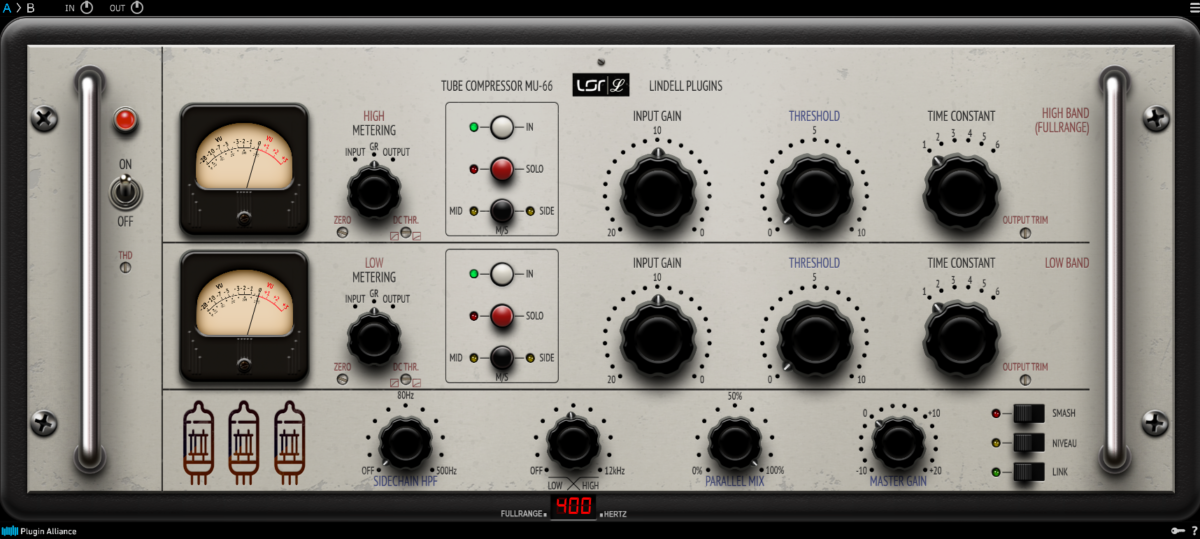
The Fairchild compressor, a legendary piece of audio equipment from the 1950s and 1960s, is known for its lush, warm sound and musicality. Designed by Rein Narma, it quickly became a staple in pro recording studios worldwide. The Fairchild compressor’s intricate tube and transformer-based design offer a unique character that enhances recordings with rich harmonics and smooth compression. We’ll explore the Fairchild compressor’s history and modern use cases while focusing on its most famous models, the 660 (mono version) and 670 (stereo version).
Jump to these sections:
- Fairchild compressor history
- What makes the Fairchild compressor unique?
- How much does a Fairchild cost?
- Add the sound of a Fairchild to your studio
Demo Lindell Audio’s MU-66 Compressor, which recreates the sound of a Fairchild 670.

Fairchild compressor history
The Fairchild compressor was developed in response to the need for high-quality broadcast equipment. Rein Narma, an innovative engineer, designed the unit to provide smooth, transparent compression while adding a pleasing warmth and character to incoming audio.
Top-end music studios quickly adopted the Fairchild because it happened to work as a great vocal compressor, bass compressor, drum bus compressor, and mastering limiter. Its ability to handle complex audio signals gracefully and musically made it an indispensable tool for mixing and mastering.
This compressor played a crucial role in shaping the sound of many classic recordings from the 1960s and 1970s. Abbey Road Studios, Capitol Studios, and Olympic Studios owned multiple Fairchild compressors, which led to the compressor’s inclusion on tracks by The Beatles, Pink Floyd, Frank Sinatra, and Led Zeppelin.
What makes the Fairchild compressor unique?
Upon its release, the Fairchild allowed producers to set a faster attack time than any other compressor on the market. This was the result of its unique variable-mu topology. A vari-mu compressor has a sidechain circuit that monitors the amplitude of the input audio signal and generates a control voltage when the signal exceeds a set threshold. The control voltage is applied to the grid of a vacuum tube, which has a variable gain characteristic; the gain of this tube decreases as the control voltage increases. This process reduces the signal’s gain as the strength of the input increases, compressing the dynamic range of the audio.
It wasn’t until FET compressors like the 1176 were developed in the late 1960s that the pro audio community gained access to even faster attack times. FET compressors have an aggressive sound that’s great for heavy vocals, guitars, and drums, but they aren’t as warm and smooth as a vari-mu compressor like the Fairchild.
1. Time Constant
The Fairchild’s Time Constant knob allows users to choose between various fast attack times and an assortment of release times. There are six settings to choose from, each suitable for a different use case. These unique attack/release combinations play a pivotal role in the characteristic sound of a Fairchild compressor.

- Time Constant 1: With an attack time of approximately 0.2 milliseconds and a release time of around 300 milliseconds, this setting is perfect for aggressive compression, effectively managing transients in percussive instruments.
- Time Constant 2: Featuring the same attack time of about 0.2 milliseconds but with a longer release of around 800 milliseconds, it’s suitable for plucked strings and fast-moving bass lines.
- Time Constant 3: An attack time of roughly 0.4 milliseconds paired with a 2-second release provides a balanced response, making it ideal for vocals or mixed program material. It ensures smoothness without excessive compression.
- Time Constant 4: This setting, with an attack time near 0.8 milliseconds and a release extending to 5 seconds, is less aggressive, allowing more initial transient through. It’s perfect for bus compression, where transparency is essential.
- Time Constant 5: With an attack time of around 0.8 milliseconds and a 5-second release, it provides smooth and transparent compression. It’s suitable for mastering, providing gentle dynamic range control without noticeable compression artifacts.
- Time Constant 6: The slowest option, with an attack time of about 0.8 milliseconds and a release time of around 25 seconds, offers subtle dynamic control over a long period. This setting is especially effective for maintaining the natural ebb and flow of more complex program material, providing an almost imperceptible compression effect that glues the mix together.
2. Left/Right and Lat/Vert
The Fairchild compressor allows you to process the left and right channels separately when set to Left/Right mode. Putting the compressor into Lat/Vert mode allows you to process the mids (Vert) and sides (Lat) separately. The Vert channel is the sum of the left and right channels, containing mono information. The Lat channel is the difference between the left and right channels, containing solely stereo information.
While mid/side processing has grown in popularity over the years, making its way into plugins like bx_clipper, bx_masterdesk PRO, and bx_XL V3 by Brainworx, it was quite uncommon in the 1960s. Most stereo audio processors operated in left/right mode. As a result, the Fairchild’s Lat/Vert mode gave it a surgical edge in pro studios.

For example, with Lat/Vert processing, you can compress the mid-channel to tighten the vocals in a mix without affecting guitars panned to the sides. This is a useful feature in a mastering context where you don’t have access to the vocal stems. Back in the 1960s, there were additional recording constraints that made Lat/Vert processing a game-changer.
Bouncing and overdubbing were essential techniques in the 1950s and 60s for managing a limited number of tape record tracks. Bouncing involved combining multiple recorded tracks onto a single track to free up space for additional recordings, while overdubbing allowed new parts to be layered over existing ones. However, once you combined multiple tracks, there was no way to separate them. The Fairchild’s Lat/Vert mode provided a significant advantage in this context by allowing engineers to independently control a mix’s mid (center) and side (stereo) elements after bouncing.
3. DC Threshold
The DC Threshold on the Fairchild controls the level at which compression is applied to the input signal. This setting adjusts the bias voltage in the sidechain circuit, which detects the signal level and triggers compression. A lower DC Threshold setting causes the compressor to engage at lower signal levels, resulting in more compression. Higher settings require a louder signal to activate compression, leaving quiet portions of the signal unaffected.

A Fairchild is a vari-mu compressor. It uses variable-mu (variable gain) tube technology to control audio signal levels. The term “mu” refers to the tube’s amplification factor, which varies in response to the input signal. However, not all compressors that contain tubes are vari-mu compressors.
An LA-2A contains tubes in the input and output stages of the amplification path, but an electroluminescent panel (EL) and light-dependent resistor (LDR) are primarily responsible for applying gain reduction. In comparison, vari-mu compressors like the Fairchild leverage tubes as the main gain reduction component. As a result of this fundamental difference in design, a Fairchild can respond faster to incoming audio signals than an LA-2A.
The Fairchild compressor is known for its “soft knee” characteristic, meaning the compression gradually increases as the signal exceeds the threshold, resulting in smooth and natural-sounding gain reduction.
While the Fairchild compressor was ahead of its time, it still meets a need in modern studios. The Fairchild’s relatively fast compression settings, in addition to the nuanced compression it applies, make it a go-to choice for vocal compression, bass compression, and mix bus compression. Its ability to musically glue buses together position the Fairchild compressor as a studio classic.
How much does a Fairchild cost?
In the 1950s, the Fairchild 670 sold for around $1,000, which was expensive. Adjusting for inflation, that would be around $10,000 today. Only 1,000 units of the 670 were produced, and fewer 660s were made. As a result of their rarity and coveted industry status, you can expect to pay roughly $25,000 for a used Fairchild 660 or $35,000 for a Fairchild 670 in 2024.
Luckily, plugins like the Lindell Audio MU-66 make adding the sound of a Fairchild to your studio much more affordable. With modern features like a sidechain high-pass filter, dual-band functionality, an adjustable crossover frequency, parallel mix knob, SMASH switch, and NIVEAU filter, the MU-66 provides even more control and flexibility than the original hardware.
Add the sound of a Fairchild to your studio
The Fairchild compressor, with its original design and enduring appeal, has played a pivotal role in shaping the sound of modern music. From its creation in the 1950s to its status as a coveted piece of audio equipment, it has been cherished for its smooth, musical compression and rich harmonic content. The Fairchild 660 and 670 models have become iconic tools in the world of audio processing, known for their ability to add warmth, depth, and character to recordings. Their legacy continues to influence and inspire, maintaining the Fairchild’s status as a timeless piece of audio gear.















